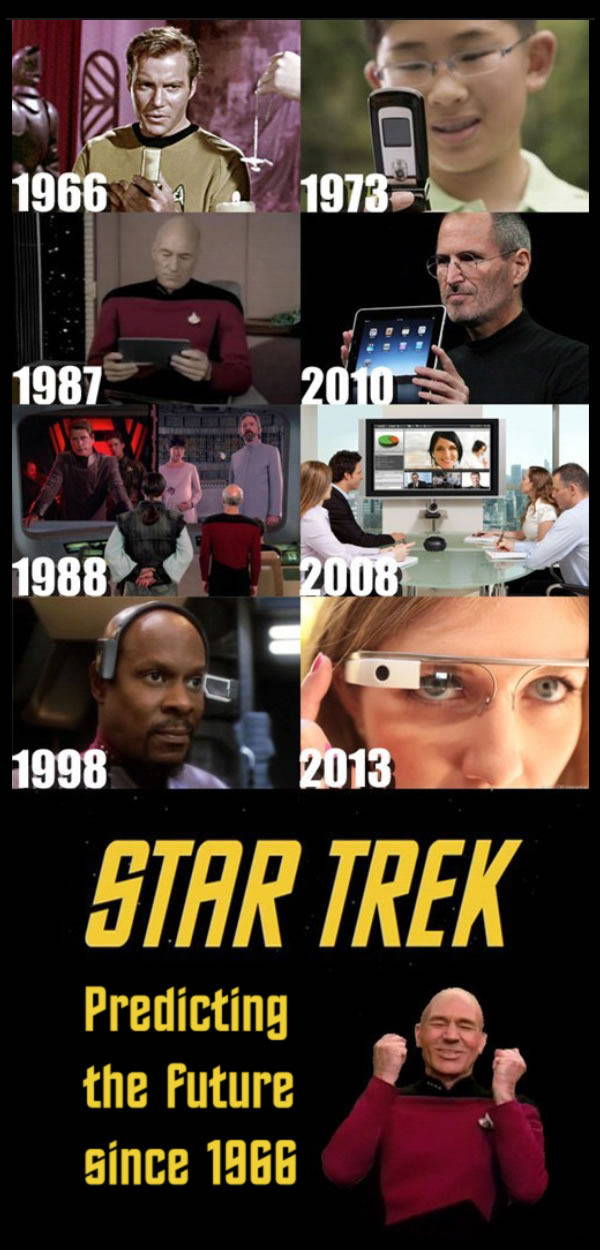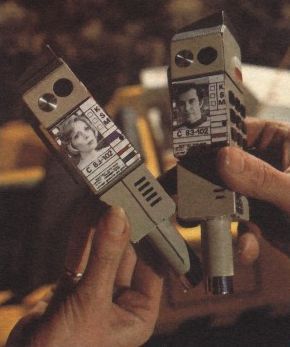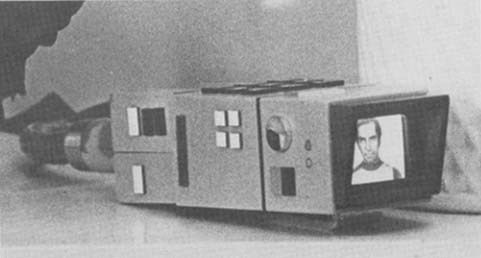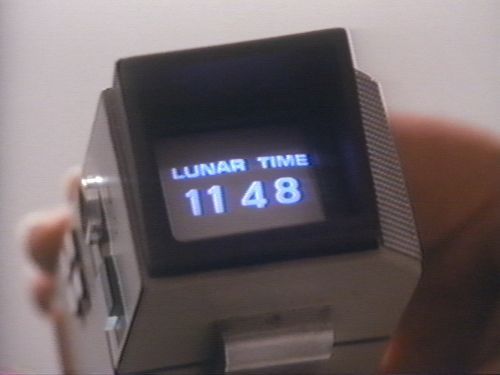That "1973" pic is more than a little misleading. The first cell phones were the size of bricks and didn't have flip tops.
-
Welcome! The TrekBBS is the number one place to chat about Star Trek with like-minded fans.
If you are not already a member then please register an account and join in the discussion!
You are using an out of date browser. It may not display this or other websites correctly.
You should upgrade or use an alternative browser.
You should upgrade or use an alternative browser.
I pose a question for the Original fans
- Thread starter Gigatron
- Start date
There is quite a bit of casual picture-taking (holo-photoing?) in Voyager, and both Tom Paris and the Doctor wrote recreational holoprograms that were intended for more than just personal use - in fact, the Doctor outright stated that he intended that his "Photons Be Free" program should be for the mass market.How often have we ever seen someone "take a photo" in the Star Trek universe? They get on a video chat via the viewscreen, but there's no selfies and snapshotting going on really, and the tricorder is more of a scanner than a camera. Rarely do we see personal photos of any kind. There's the hologram of Tasha that Data has, and the old school photo of David Marcus in Trek VI and most else are official ID photos. There's also no mass market entertainment that I can see, no TV networks or news channels outside of the one scene in Generations where Kirk is interviewed by "the press". The Trek universe just has certain cultural omissions like this.
How can one imagine what has yet been imagined, or what will be invented? After all, an invention by its very nature is an original idea. You couldn't have convinced me of the proliferation of the networks that we have today when I was studying computers in 1985. -And I was studying computers. The idea of digital voice was in its infancy when Trek went on the air, so it was likely unknown to all but a few theoretical computer scientists at the time. It's up to the writers to imagine these things, and sometimes, despite their active imaginations, they cannot even conceive of what technology will do for us in the future.
Just one thing:

That graphic is a good idea, but I think it needs some tweaks. Is it even possible that the flip phone could have existed in 1973? I think that one is off by more than a decade.
Also, the wall-mounted flat screen in the 1988 TNG image is pre-dated by 1966 TOS episodes. And there's a strikingly modern flat screen TV in "Requiem for Methuselah," used by Flint to monitor Kirk and Spock.
Some of the actions seen in TOS might be retconned as AI in action, or at least voice recognition. For example, in "The Conscience of the King" Kirk contacts the Enterprise and asks Uhura, "Put me through to Captain Jon Daily of the AstraI Queen on orbit station, and put it on scramble."
Scrambling the communication, and Kirk's own words to Daily, "Just keep this between the two of us and accept my thanks" suggests that Uhura did not stay in the loop. So unless Kirk pressed a button on the communicator (an action too slight to see on camera*) just after finishing his discussion with Daily, his next line, "Kirk to Enterprise" suggests voice recognition by the ship's computers. Otherwise, how would Uhura step back into the call?
* Actually, Shatner does make a two-finger grab at one of the tiny knobs, his middle finger tapping the side of the communicator. But to me, that scene always looked like voice recognition in action.
The communicator definitely performs what we call voice dialing. Kirk demonstrates it in "This Side of Paradise" and "Shore Leave." That was so far out to me in the 1970s that I couldn't even come up with a fictional-tech explanation for it. The idea that Kirk's communicator contained a computer that could recognize "Kirk to Spock" and beep only Spock's communicator didn't even occur to me-- computers just weren't that small and we didn't expect them to be.
There's a 1968 episode of Mission: Impossible called "The Freeze," in which they convince a guy he's been cryogenically frozen and awakened in the far-future year of... 1980! The future technology includes a giant flatscreen TV that's remarkably modern-looking, complete with a bank of small cartridges containing video recordings. (It also contains a Trek reference, a mention of "cordrazine.")
Didn't the Romulan War series somewhat retcon this by explaining that the computers were intentionally isolated to prevent the Romulan telecapture device from being able to seize control of Federation vessels?
Wonder where the frak they came up with that bit of plotting?

Row 1, flip phone: it's a lid/antenna, not a displayJust one thing:

Row 2, tablet display: see 2001 A Space Odyssey in 1968
Row 3 split screen video conference: mmmmmaybe
Row 4, eyepiece: The Last Starfighter had those in 1986
In the mid-seventies, the Apache attack helicopter featured the "integrated helmet and display sighting system."Row 4, eyepiece: The Last Starfighter had those in 1986


Row 1, flip phone: it's a lid/antenna, not a display
Row 2, tablet display: see 2001 A Space Odyssey in 1968
Row 3 split screen video conference: mmmmmaybe
Row 4, eyepiece: The Last Starfighter had those in 1986
- That's correct about 2001's intentions, but it was easy to miss in the movie because the astronauts never picked them up. I mistook them for monitors mounted in the tabletop, that could swivel a few degrees left and right.
- Ah, Row 3 is about split screen conferencing. I thought it was just about flat screens. I withdraw my prior comment on that one.
I'm not certain this was an oversight. Isolating the landing party to varying degrees was part of many planet-side episodes. In addition to the increased jeopardy, it allowed for dialogue that would have been redundant with visual communication.They didn't even provide for cameras in the communicators, an odd oversight since the personal transmitters in Forbidden Planet included the feature.
More mundane production cost considerations might have played a part in that decision. Perhaps Harvey might know more.
I don't have any memos to share at the moment, but broadly speaking, voice over is cheap, an optical allowing for visual communication isn't.
I don't have any memos to share at the moment, but broadly speaking, voice over is cheap, an optical allowing for visual communication isn't.
And it isn't just the money.
- The cost of inserting communicator close-ups would inevitably lead to using a stock shot, into which a new picture could be matted each week. For example, the tricorder close-up in "City on the Edge of Forever" was recycled for "The Empath" and "Plato's Stepchildren." But the communicator is used so often, the stock shot would become painfully familiar (like many shots did in TAS, the animated series).
- It would slow the story down if every landing party had to take time out to show the bridge what was going on. As soon as the novelty wears off, it creates a needless "remove" from the action.
Space: 1999 did this a bit with their commlock props. One hero version had an actual working CRT in it, but it had to be connected to a fat cable (middle image) to operate.



The TOS flip-top communicator was a field-equipment item, made to be easily disassembled, repaired or adapted
If this argument is to justify the "bulky" size of the TOS communicator relative to the TNG design, then it won't wash. Despite the examples you've given, the communicators aren't Glock pistols that can be completely disassembled and reassembled with a single, pocket-sized tool. Even a child's walkie-talkie from the '70s was too complicated to service without bench tools. Clever, in-the-field gimmicks with technology are fun in fiction, but they don't happen that easily in real life.
KIRK: (in pain) I don't care if you hit the broad side of a barn. Just hurry, please.
SPOCK: Captain, why should I aim at such a structure?
The TOS communicator was—relative to the technology of the '60s—highly advanced and compact, and recognizably a radio.
One of the minor challenges in going back and really properly rebooting TOS. The communicator and the tricorder are really one device now, aren't they?
Kinda like the early Gold Key comics, when the artist continually mistook the tricorder for a communicator. And only Kirk carried one. Good times.
- It would slow the story down if every landing party had to take time out to show the bridge what was going on. As soon as the novelty wears off, it creates a needless "remove" from the action.
Why would they have to take time out? There could be continuous visual monitoring as a matter of course.
In the '70s, TOS's associate producer Bob Justman produced a show called Search, a spy-ish series about an organization that used high-tech methods to track down important items or people. Their agents wore medallions with microcameras built in and had radio transceivers implanted in their teeth, so their every move was routinely watched and listened to by the operatives back at the command center (led by Burgess Meredith). It was surprisingly prescient of modern spy and military shows/movies where you see the field agents constantly observed and advised by the team back in the command center. It didn't slow down the action to have the leads stop to communicate with the base, because they were always being monitored from the base.
For an example more contemporary to TOS, there's The Time Tunnel. The team back at Project Tic-Toc was constantly monitoring Tony and Doug's actions in the past, often watching them through the tunnel and occasionally able to affect events, if not communicate directly. And TOS did episodes where the bridge crew were able to monitor someone's actions on a planet through alien intervention, such as "Arena" and "The Gamesters of Triskelion." There's no reason they couldn't have done the same thing more routinely, although they probably would've had to cheat the camera angles a lot.
If this argument is to justify the "bulky" size of the TOS communicator relative to the TNG design, then it won't wash.
Don't know what you're talking about. Why the confrontation tone?
In the '70s, TOS's associate producer Bob Justman produced a show called Search, a spy-ish series about an organization that used high-tech methods to track down important items or people. Their agents wore medallions with microcameras built in and had radio transceivers implanted in their teeth, so their every move was routinely watched and listened to by the operatives back at the command center (led by Burgess Meredith). It was surprisingly prescient of modern spy and military shows/movies where you see the field agents constantly observed and advised by the team back in the command center. It didn't slow down the action to have the leads stop to communicate with the base, because they were always being monitored from the base.
For an example more contemporary to TOS, there's The Time Tunnel. The team back at Project Tic-Toc was constantly monitoring Tony and Doug's actions in the past, often watching them through the tunnel and occasionally able to affect events, if not communicate directly. And TOS did episodes where the bridge crew were able to monitor someone's actions on a planet through alien intervention, such as "Arena" and "The Gamesters of Triskelion." There's no reason they couldn't have done the same thing more routinely, although they probably would've had to cheat the camera angles a lot.
I did think about Search when I wrote my post, but I still concluded that it was not the way I'd want TOS to go. We can differ on that. Granted, if I were sending real spacemen down to the surface of Rigel XII, they should absolutely take a camera. No bones about it.
My memory is hazy on actual Search episodes (I was ten), but I'll bet they cheated the camera angles like crazy.
Lately, where I've been seeing Robert Justman is his listing as assistant director on some Adventures of Superman episodes. And that's a great show.
The communicator was able to contact a ship many thousand of miles away in orbit, and there was mention of it possessing a subspace transmitter (Mirror Mirror). These two things could account for it's size.If this argument is to justify the "bulky" size of the TOS communicator relative to the TNG design, then it won't wash.
It apparently also was important (but not essential) to beaming.
Modern day smartphones intended for all-weather outdoor rugged use are "bulky" owing to their protective shells.

The communicator was able to contact a ship many thousand of miles away in orbit, and there was mention of it possessing a subspace transmitter (Mirror Mirror). These two things could account for it's size.
It apparently also was important (but not essential) to beaming.
Modern day smartphones intended for all-weather outdoor rugged use are "bulky" owing to their protective shells.

In "Mudd's Women," Harry uses a communicator on "subspace frequency 3-9." So I agree, the prop's size can be justified. It's only the limited control panel and lack of features that are hard to explain.
I don't have any memos to share at the moment, but broadly speaking, voice over is cheap, an optical allowing for visual communication isn't.
And it isn't just the money.
- The cost of inserting communicator close-ups would inevitably lead to using a stock shot, into which a new picture could be matted each week. For example, the tricorder close-up in "City on the Edge of Forever" was recycled for "The Empath" and "Plato's Stepchildren." But the communicator is used so often, the stock shot would become painfully familiar (like many shots did in TAS, the animated series).
- It would slow the story down if every landing party had to take time out to show the bridge what was going on. As soon as the novelty wears off, it creates a needless "remove" from the action.
Space: 1999 did this a bit with their commlock props. One hero version had an actual working CRT in it, but it had to be connected to a fat cable (middle image) to operate.



The commlock with that mini CRT display was pretty cutting-edge for 1973. But then Helena used to use a typewriter to write her reports..a typewriter...
Similar threads
- Replies
- 32
- Views
- 2K
- Replies
- 0
- Views
- 324
- Replies
- 0
- Views
- 6K
If you are not already a member then please register an account and join in the discussion!
